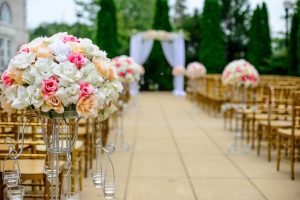
A good Rabbi tries to have a repertoire of inspiring Torah thoughts to draw upon at a moment’s notice. One never knows when one may be called upon to speak. Stocking up on a few divrei Torah, and rolling one of them out when asked to say a few words, however, often falls somewhat short. These recycled thoughts tend to sound rehearsed, lacking spontaneity and freshness.
The remedy I have found is to internalize a few ideas and thoughts about which one is truly passionate and which are so fundamental they apply almost universally. They ideas do not have to be twisted and stretched to fit an occasion, but spring forth naturally, almost of their own accord.
One such thought is particularly suited to wedding or sheva brochos events. It is related to the famous saying of the sages that the bringing together of husband and wife is as difficult to accomplish as the splitting of the Yam Suf, the Red Sea. This is difficult to understand. For Hashem, the miraculous and the natural are one; both require no effort. This is reflected in the Torah’s description of the splitting of the sea that we read in this week’s Torah portion: Moshe lifted up his staff and the waters split with a mighty roar. In what way can this miracle be understood as “difficult” for Hashem?
Furthermore, don’t the Sages tell us that Hashem had programmed into the Creation that the Red sea should part for the Jews on their way to the promised land? Where is the parallel between this pre-ordained miracle and the pairing of chosson and kallah ?
The answer lies in the fundamental concept that what appears in any given “shidduch” to be a new union of two separate individuals, is actually the re-unification of those two components that were formerly a single entity.
This process is readily apparent in the miracle of the splitting of the sea. Before it split, it was one entity – a large body of water flowing in an uninterrupted manner. It then split into two walls, one opposite the other, to fulfill G-d’s will and allow the Jewish people to pass through. At the conclusion of their mission, the two walls came crashing down and united as before.
In a parallel vein, the souls of husband and wife were actually one unit in the celestial fields before they descended to earth. The original man, Adom, and his wife, Chava, were previously two sides of one person. They were then separated in order that each serve as an ezer k’negdo, a corresponding support of strength to one another. So too, in this world, a soul is split into two units and invested in separate bodies with entirely different life conditions. They come together as husband and wife, and at the end of life’s journey, the two souls will once again reunite in heaven as one for eternity.
It is for this reason that the Talmud teaches us that Rav Chiya would dance before a bride and groom, reminding them of the day of death. He wasn’t simply sobering them up to the day of reality; he was adding to their joy and giving them a deeper awareness and appreciation that finding one another and living as husband and wife is merely a reflection of a deeper reality. Their true marriage was and will be for eternity in the world to come.
Drawing on a personal experience helps me to conceptualize this rather esoteric and mystical concept. My father of blessed memory, was a passionate collector of Hebraic. His stellar collection included many 16th century works and I benefited greatly from his fascinating knowledge of the great authors in the Jewish communities where these profound seforim were produced. To a collector, the title page of any early work is the most valuable part of the book as it provides all the vital details and information regarding the author and the sefer’s origin. The information was invariably imparted in a beautiful woodcut. Yet, the title page more often than not in bad condition, tattered and worn, if not wholly ruined.
My father would painstakingly assemble the fragments and have them re-sewn together. He delighted in showing me some restored title pages in which it was hard to detect that the pieces had been delicately re-glued and resewn. However, when the page was lifted to the light, the thick lines and patches were clearly visible; one could see that the page was carefully reconstructed.
One time, my father acquired a particularly valuable work with a badly torn title page. A friend referred him to a master craftsman who worked for the British museum restoring old Paris manuscripts. My father was delighted when this man accepted the book and agreed to restore it. He cautioned my father that this would take a few years and he couldn’t give a precise date for its return.
I recall the happy occasion when this sefer was finally returned. That Friday night after the meal, my father produced this sefer from its place on the bookshelf with a triumphant flourish. “Look!” he told me. “Lift up the title page to the light and see what a craftsman this fellow is!” Only after squinting carefully at the page could I faintly detect the seam lines where the page had been restored. It was truly a master craftsman’s work of art.
Husband and wife are part of the same “title page.” A single entity is separated into two souls by Hashem and ordained from the beginning of time to be re-united in this world. The true ideal union is achieved when we respect, accommodate and empathize with one another. When we reach this level of union, learning to live for one another with the goalof fulfilling the will of our Creator, then just as the two pillars of water merged seamlessly after all the Jews passed through, we too will be seamlessly integrated in the Hereafter.
There is no greater blessing to offer a chosson and kallah than that they should be zoche to this exalted union. It is a blessing that leads to the spiritual bliss we all strive for.
Wishing you a wonderful Shabbos.
Rabbi Naftali Reich
Text Copyright © 2014 by Rabbi Naftali Reich and Torah.org.
Rabbi Reich is on the faculty of the Ohr Somayach Tanenbaum Education Center.


